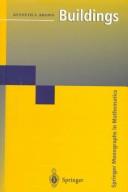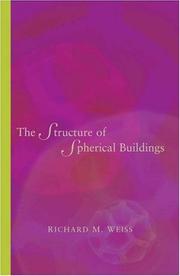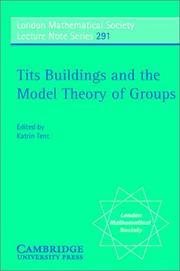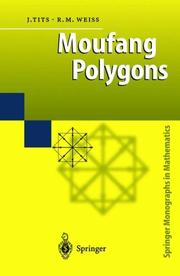| Listing 1 - 10 of 10 |
Sort by
|

ISBN: 0387968768 3540968768 1461269873 1461210194 9780387968766 Year: 1989 Publisher: New York (N.Y.): Springer,
Abstract | Keywords | Export | Availability | Bookmark
 Loading...
Loading...Choose an application
- Reference Manager
- EndNote
- RefWorks (Direct export to RefWorks)
Buildings (Group theory) --- Continuum mechanics --- Continuum mechanics. --- Buildings (Group theory).
Book
ISBN: 9781400874019 1400874017 Year: 2015 Publisher: Princeton : Princeton University Press,
Abstract | Keywords | Export | Availability | Bookmark
 Loading...
Loading...Choose an application
- Reference Manager
- EndNote
- RefWorks (Direct export to RefWorks)
Descent in Buildings begins with the resolution of a major open question about the local structure of Bruhat-Tits buildings. The authors then put their algebraic solution into a geometric context by developing a general fixed point theory for groups acting on buildings of arbitrary type, giving necessary and sufficient conditions for the residues fixed by a group to form a kind of subbuilding or "form" of the original building. At the center of this theory is the notion of a Tits index, a combinatorial version of the notion of an index in the relative theory of algebraic groups. These results are combined at the end to show that every exceptional Bruhat-Tits building arises as a form of a "residually pseudo-split" Bruhat-Tits building. The book concludes with a display of the Tits indices associated with each of these exceptional forms.This is the third and final volume of a trilogy that began with Richard Weiss' The Structure of Spherical Buildings and The Structure of Affine Buildings.

ISBN: 0691117330 9780691117331 0691216045 Year: 2003 Publisher: Princeton (N.J.): Princeton university press,
Abstract | Keywords | Export | Availability | Bookmark
 Loading...
Loading...Choose an application
- Reference Manager
- EndNote
- RefWorks (Direct export to RefWorks)

ISBN: 1139881434 1107365678 1107370418 1107360765 1107370167 1299403492 1107363217 0511549784 9781107360761 9780511549786 9781107365674 0521010632 9780521010634 7330521010633 Year: 2002 Publisher: Cambridge New York Cambridge University Press
Abstract | Keywords | Export | Availability | Bookmark
 Loading...
Loading...Choose an application
- Reference Manager
- EndNote
- RefWorks (Direct export to RefWorks)
This volume contains selected papers by leading researchers from the international conference entitled Tits Buildings and the Model Theory of Groups, held in Würzburg in 2000. The first part of the book provides a general introduction to many aspects of buildings and their geometries, based on short lecture courses given at the conference. The rest of the book comprises survey and research articles on model theoretic results and techniques, showing the vitality and richness of these branches of mathematics. Among the most fruitful techniques, amalgamation constructions à la Hrushovski are explained and classified as they continue to play an important role both in model theory and geometry. The articles succeed in demonstrating the close connection between geometry, group theory and model theory. The book will be invaluable to graduate students as well as experienced researchers working in these areas of mathematics.
Book
ISBN: 1283144867 9786613144867 9814317578 9789814317573 9781283144865 9789814317566 981431756X 661314486X Year: 2010 Publisher: Singapore Hackensack, NJ World Scientific
Abstract | Keywords | Export | Availability | Bookmark
 Loading...
Loading...Choose an application
- Reference Manager
- EndNote
- RefWorks (Direct export to RefWorks)
Buildings are combinatorial constructions successfully exploited to study groups of various types. The vertex set of a building can be naturally decomposed into subsets called Grassmannians. The book contains both classical and more recent results on Grassmannians of buildings of classical types. It gives a modern interpretation of some classical results from the geometry of linear groups. The presented methods are applied to some geometric constructions non-related to buildings - Grassmannians of infinite-dimensional vector spaces and the sets of conjugate linear involutions. The book is self

ISBN: 0521010632 9780521010634 9780511549786 Year: 2002 Volume: 291 Publisher: Cambridge Cambridge University Press
Abstract | Keywords | Export | Availability | Bookmark
 Loading...
Loading...Choose an application
- Reference Manager
- EndNote
- RefWorks (Direct export to RefWorks)
Buildings (Group theory) --- Buildings (Group theory). --- Group theory. --- Group theory --- Immeubles (Théorie des groupes) --- Théorie des groupes
Book
ISBN: 9781108831963 9781108933049 1108831966 Year: 2023 Publisher: Cambridge ;New York Cambridge University Press
Abstract | Keywords | Export | Availability | Bookmark
 Loading...
Loading...Choose an application
- Reference Manager
- EndNote
- RefWorks (Direct export to RefWorks)
"Bruhat-Tits theory is an important topic in number theory, representation theory, harmonic analysis, and algebraic geometry. This book gives the first comprehensive treatment of this theory over discretely valued Henselian fields. It can serve both as a reference for researchers in the field and as a thorough introduction for graduate students and early career mathematicians. Part I of the book gives a review of the relevant background material, touching upon Lie theory, metric geometry, algebraic groups, and integral models. Part II gives a complete, detailed, and motivated treatment of the core theory. For more experienced readers looking to learn the essentials for use in their own work, there is also an axiomatic summary of Bruhat-Tits theory that suffices for the main applications. Part III treats modern topics that have become important in current research. Part IV provides a few sample applications of the theory. The appendices contain further details on the topic of integral models, including a detailed study of the integral models of tori."
Buildings (Group theory) --- Number theory --- Number study --- Numbers, Theory of --- Algebra --- Theory of buildings (Group theory) --- Tits's theory of buildings (Group theory) --- Linear algebraic groups --- 511 --- 511 Number theory
Book
ISBN: 9780387788357 0387788344 9780387788340 0387788352 9786611954338 1281954330 Year: 2008 Volume: 251 Publisher: New York (N.Y.): Springer,
Abstract | Keywords | Export | Availability | Bookmark
 Loading...
Loading...Choose an application
- Reference Manager
- EndNote
- RefWorks (Direct export to RefWorks)
This book treats Jacques Tits's beautiful theory of buildings, making that theory accessible to readers with minimal background. It includes all the material of the earlier book Buildings by the second-named author, published by Springer-Verlag in 1989, which gave an introduction to buildings from the classical (simplicial) point of view. This new book also includes two other approaches to buildings, which nicely complement the simplicial approach: On the one hand, buildings may be viewed as abstract sets of chambers with a Weyl-group-valued distance function; this point of view has become increasingly important in the theory and applications of buildings. On the other hand, buildings may be viewed as metric spaces. Beginners can still use parts of the new book as a friendly introduction to buildings, but the book also contains valuable material for the active researcher. There are several paths through the book, so that readers may choose to concentrate on one particular approach. The pace is gentle in the elementary parts of the book, and the style is friendly throughout. All concepts are well motivated. There are thorough treatments of advanced topics such as the Moufang property, with arguments that are much more detailed than those that have previously appeared in the literature. This book is suitable as a textbook, with many exercises, and it may also be used for self-study.
Buildings (Group theory) --- Immeubles (Théorie des groupes) --- Buildings (Group theory). --- Algebra --- Mathematics --- Physical Sciences & Mathematics --- Linear algebraic groups. --- Immeubles (Théorie des groupes) --- EPUB-LIV-FT LIVMATHE LIVSTATI SPRINGER-B --- Theory of buildings (Group theory) --- Tits's theory of buildings (Group theory) --- Algebraic groups, Linear --- Mathematics. --- Algebraic geometry. --- Group theory. --- Topological groups. --- Lie groups. --- Group Theory and Generalizations. --- Algebraic Geometry. --- Topological Groups, Lie Groups. --- Geometry, Algebraic --- Group theory --- Algebraic varieties --- Linear algebraic groups --- Geometry, algebraic. --- Topological Groups. --- Groups, Topological --- Continuous groups --- Algebraic geometry --- Geometry --- Groups, Theory of --- Substitutions (Mathematics) --- Groups, Lie --- Lie algebras --- Symmetric spaces --- Topological groups --- Geometry, Algebraic.

ISSN: 14397382 ISBN: 3540437142 3642078338 366204689X 9783540437147 Year: 2002 Publisher: Berlin: Springer,
Abstract | Keywords | Export | Availability | Bookmark
 Loading...
Loading...Choose an application
- Reference Manager
- EndNote
- RefWorks (Direct export to RefWorks)
This book gives the complete classification of Moufang polygons, starting from first principles. In particular, it may serve as an introduction to the various important algebraic concepts which arise in this classification including alternative division rings, quadratic Jordan division algebras of degree three, pseudo-quadratic forms, BN-pairs and norm splittings of quadratic forms. This book also contains a new proof of the classification of irreducible spherical buildings of rank at least three based on the observation that all the irreducible rank two residues of such a building are Moufang polygons. In an appendix, the connection between spherical buildings and algebraic groups is recalled and used to describe an alternative existence proof for certain Moufang polygons.
Moufang loops --- Buildings (Group theory) --- Moufang, Boucles de --- Immeubles (Théorie des groupes) --- Moufang loops. --- Graph theory --- Graph theory. --- Buildings (Group theory). --- Immeubles (Théorie des groupes) --- Geometry. --- Algebra. --- Discrete mathematics. --- Algebraic geometry. --- Group theory. --- Combinatorics. --- Discrete Mathematics. --- Algebraic Geometry. --- Group Theory and Generalizations. --- Combinatorics --- Algebra --- Mathematical analysis --- Groups, Theory of --- Substitutions (Mathematics) --- Algebraic geometry --- Geometry --- Discrete mathematical structures --- Mathematical structures, Discrete --- Structures, Discrete mathematical --- Numerical analysis --- Mathematics --- Euclid's Elements
Book
ISBN: 9780691136592 0691136599 9780691138817 0691138818 9786612458361 1282458361 1400829054 9781400829057 9781282458369 6612458364 Year: 2009 Volume: 168 Publisher: Princeton, N.J. Princeton University Press
Abstract | Keywords | Export | Availability | Bookmark
 Loading...
Loading...Choose an application
- Reference Manager
- EndNote
- RefWorks (Direct export to RefWorks)
In The Structure of Affine Buildings, Richard Weiss gives a detailed presentation of the complete proof of the classification of Bruhat-Tits buildings first completed by Jacques Tits in 1986. The book includes numerous results about automorphisms, completions, and residues of these buildings. It also includes tables correlating the results in the locally finite case with the results of Tits's classification of absolutely simple algebraic groups defined over a local field. A companion to Weiss's The Structure of Spherical Buildings, The Structure of Affine Buildings is organized around the classification of spherical buildings and their root data as it is carried out in Tits and Weiss's Moufang Polygons.
Buildings (Group theory) --- Moufang loops --- Automorphisms --- Affine algebraic groups --- Moufang loops. --- Automorphisms. --- Affine algebraic groups. --- Algebraic groups, Affine --- Loops, Moufang --- Theory of buildings (Group theory) --- Tits's theory of buildings (Group theory) --- Group schemes (Mathematics) --- Group theory --- Symmetry (Mathematics) --- Loops (Group theory) --- Linear algebraic groups --- Buildings (Group theory). --- Addition. --- Additive group. --- Additive inverse. --- Algebraic group. --- Algebraic structure. --- Ambient space. --- Associative property. --- Automorphism. --- Big O notation. --- Bijection. --- Bilinear form. --- Bounded set (topological vector space). --- Bounded set. --- Calculation. --- Cardinality. --- Cauchy sequence. --- Commutative property. --- Complete graph. --- Complete metric space. --- Composition algebra. --- Connected component (graph theory). --- Consistency. --- Continuous function. --- Coordinate system. --- Corollary. --- Coxeter group. --- Coxeter–Dynkin diagram. --- Diagram (category theory). --- Diameter. --- Dimension. --- Discrete valuation. --- Division algebra. --- Dot product. --- Dynkin diagram. --- E6 (mathematics). --- E7 (mathematics). --- E8 (mathematics). --- Empty set. --- Equipollence (geometry). --- Equivalence class. --- Equivalence relation. --- Euclidean geometry. --- Euclidean space. --- Existential quantification. --- Free monoid. --- Fundamental domain. --- Hyperplane. --- Infimum and supremum. --- Jacques Tits. --- K0. --- Linear combination. --- Mathematical induction. --- Metric space. --- Multiple edges. --- Multiplicative inverse. --- Number theory. --- Octonion. --- Parameter. --- Permutation group. --- Permutation. --- Pointwise. --- Polygon. --- Projective line. --- Quadratic form. --- Quaternion. --- Remainder. --- Root datum. --- Root system. --- Scientific notation. --- Sphere. --- Subgroup. --- Subring. --- Subset. --- Substructure. --- Theorem. --- Topology of uniform convergence. --- Topology. --- Torus. --- Tree (data structure). --- Tree structure. --- Two-dimensional space. --- Uniform continuity. --- Valuation (algebra). --- Vector space. --- Without loss of generality.
| Listing 1 - 10 of 10 |
Sort by
|

 Search
Search Feedback
Feedback About UniCat
About UniCat  Help
Help News
News